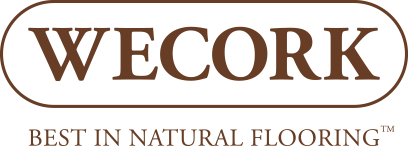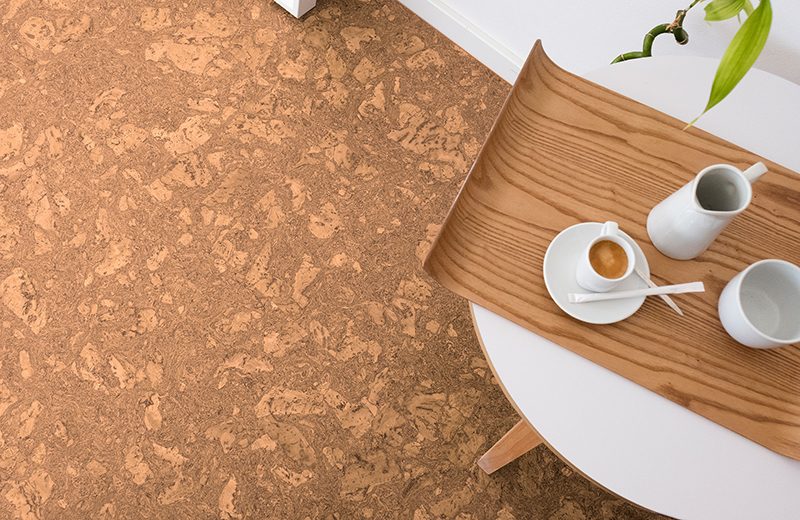Cork flooring provides many natural benefits, but how does it compare to carpet? This article explains the similarities and differences of cork vs carpet, and the value they each provide.
What Is Typical Carpet?
The comparison with carpets is mostly a comparison with synthetic carpet. In their article on Natural vs. Synthetic Carpet Fibers Compared, the Spruce states:
“Synthetic materials are those not found in nature. They are machine-made from various chemical compounds. Synthetic fibers represent the vast majority of carpet fibers sold today. There are four major types of synthetic fiber used in carpeting: nylon, polyester, polypropylene (olefin), and the newest synthetic carpet fiber, triexta.”
They further explain that synthetic fiber carpets are considered more practical than natural carpet fibers because they are less expensive, while being more durable and stain resistant. Other strengths of synthetic fibers are that they are soft and warm to walk on, and they provide good sound proofing (more on this later).
Health Concerns with Synthetic Carpet
The American Lung Association describes in the How can carpet impact health? section of the carpet page:
"Carpets may trap pollutants and allergens like dust mites, pet dander, cockroach allergens, particle pollution, lead, mold spores, pesticides, dirt and dust. Toxic gasses in the air can stick to small particles that settle into carpets. These pollutants may become airborne during renovations, vacuuming or even walking on the carpet…If a large area is covered in carpet, it may be very difficult to remove indoor air pollutants and allergens."
In light of these issues, they make some telling recommendations:
"Instead of carpets, chose hard-surfaced flooring and rugs that can be removed and cleaned outside."
This is in stark contrast with the cleanliness of cork. This will be explained below, in regards to the naturally occurring Suberin in cork.
The Challenge of Maintaining Clean Carpets
Interestingly enough, hotels seem to be catching on. The hospitality industry appears to be moving away from carpeting over the difficulties in maintaining cleanliness. In their Why Companies Are Switching to Hard Surface for Hotel Flooring, MSI paints the picture:
"Soft materials are too challenging. A lot of hotels are ditching carpet for flooring and other surfaces that are more easily maintainable…
"And while area rugs are easier to clean than wall-to-wall carpets, some are even getting rid of them altogether. That’s because they’re becoming too hard and time-consuming to keep clean…
"Carpets are difficult to keep clean and looking fresh. Not only does it take longer to maintain, but you also have to consider the amount of dry time it takes before it’s ready to be used again."
Therein lies the two-fold challenge with keeping carpets clean. First, all of the things they “trap” (as outlined above by the American Lung Association). Second, the impracticality of properly cleaning them on an ongoing basis.
The Natural Wonder of Cork
And then there is cork. Known botanically as Quercus Suber, cork comes from the bark of cork oak trees that flourish predominantly in the Mediterranean region.
Cork is a 100% rapidly-renewable resource! In fact, the cork oaks tree is the only tree whose bark can regenerate itself after harvest, leaving the tree unharmed. Cork is harvested every nine years with a careful process that does not harm the trees, allowing them to live for up to 250 years! Cork’s unique physical properties are unmatched by any other material, producing key benefits that set it above and apart.
Cork is a naturally superior material for flooring because it is:
Learn more about cork’s unique physical properties on our Benefits of Cork page.
All Those Air Cells!
Every cubic inch of cork has more than 200 million completely enclosed air cells, each measuring 1/1000″ in diameter. These minute cells have 14 sides, virtually eliminating empty spaces between the cells. Since 50% of cork is filled with air, it essentially acts as an air cushion, absorbing vibrations and direct impacts.
All those air cells make cork excellent for soundproofing above and below floors and ceilings. A Soundproof Central article on Cork vs Carpet: Which Is Better for Soundproofing? states that:
"While both are good soundproofing options, cork is the best material for soundproofing. Cork is a great way to soundproof any room of your house because it is relatively inexpensive, sustainable, and shows more versatility than carpet in its applications.
"Both carpet and cork are good options when reducing sound transmission in your household or business. Cork is the best overall choice because it is more mold tolerant, versatile, and effective at absorbing sound.
"Cork also provides excellent acoustics due to the way that it absorbs sound. When you need to reduce sound transmission between walls and floors, cork will be the best option you can choose for soundproofing."
Those same air cells make cork great for acoustics, reducing the echoes within the room. They also give cork its resilience, making it soft and comfortable underfoot. You’re literally walking on air! Additionally, the “dead” air space makes cork one of the most efficient non-conductors of heat, next to a vacuum. This keeps floors warm to the touch, effectively inhibiting cold transfer from the subfloor.
Suberin for Good Health
The cork tree coats itself with Suberin when its bark is removed. Getting slightly technical, Suberin’s main function is to act as a barrier to movement of water and solutes.
Practically speaking, this sappy substance protects the cork tree from mold, mildew and insects. Fortunately for us, Suberin grows into the cork as well. This generates unsurpassed anti-fungal and hypoallergenic properties in cork material. As a result, cork flooring does wonders for anyone who has allergies, or is sensitive to mold and mildew.
Cleaning a cork floor simply means giving it a regular sweep or vacuum to avoid the build up of abrasive material. Occasionally wiping down the floor with a cleaning solution is also important.
WECORK flooring carries a either 20 or 25 year residential wear warranty based on its finish, in addition to its lifetime structural warranty. This guarantees that the surface wear layer will not wear through or separate from the center core. Optimal performance and longevity and cork floors can be achieved by following our maintenance recommendations.
Comparing Advantages of Cork vs Carpet
So how does it all stack up? Summarizing all of the factors discussed in this article, the chart below offers a quick reference when comparing cork flooring vs typical synthetic carpet:
CORK VS CARPET COMPARISON CHART
| Factor | Cork | Carpet |
| Soundproofing & Acoustics | Advantage | |
| Cleanliness | Advantage | |
| Sustainability | Advantage | |
| Maintenance | Advantage | |
| Comfort | Similar | Similar |
| Warmth | Similar | Similar |
| Durability | Similar | Similar |
| Cost | Advantage |
Some natural fiber carpets such as wool, cotton, and silk will address some of the issues of typical synthetic carpets, although that is not uniform across the board. For example, natural fibers are generally more environmentally friendly. However, they are not as stain resistant or as easy to maintain, plus they are more expensive. Having a higher cost eliminates the main reason for choosing carpet over cork.
Ready to Specify Cork or Get Samples?
We hope this article has been helpful for comparing the benefits and value of cork flooring vs carpet. WECORK offers a variety of floating (Uniclic system) and glue-down cork floors for consideration.
Visit our sample store for samples of individual colors or collections, or to specify our cork floors see our Architects & Designers page. For further assistance, you can always feel free to Contact WECORK today!












